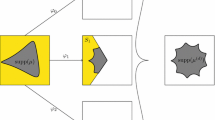Abstract
We consider the zeros of the partition function of the Ising model with ferromagnetic pair interactions and complex external field. Under the assumption that the graph with strictly positive interactions is connected, we vary the interaction (denoted by t) at a fixed edge. It is already known that each zero is monotonic (either increasing or decreasing) in t; we prove that its motion is local: the entire trajectories of any two distinct zeros are disjoint. If the underlying graph is a complete graph and all interactions take the same value \(t\ge 0\) (i.e., the Curie-Weiss model), we prove that all the principal zeros (those in \(i[0,\pi /2)\)) decrease strictly in t.

Similar content being viewed by others
Data Availability
Data sharing is not applicable to this article as no datasets were generated or analysed during the current study.
References
Ahlfors, L.V.: Complex Analysis. International Series in Pure and Applied Mathematics, 3rd edn. McGraw-Hill Book Co., New York (1978). An Introduction to the Theory of Analytic Functions of One Complex Variable
Bena, I., Droz, M., Lipowski, A.: Statistical mechanics of equilibrium and nonequilibrium phase transitions: the Yang-Lee formalism. Int. J. Mod. Phys. B 19(29), 4269–4329 (2005)
Biskup, M., Borgs, C., Chayes, J.T., Kleinwaks, L.J., Kotecký, R.: Partition function zeros at first-order phase transitions: a general analysis. Commun. Math. Phys. 251(1), 79–131 (2004)
Biskup, M., Borgs, C., Chayes, J.T., Kotecký, R.: Partition function zeros at first-order phase transitions: Pirogov-Sinai theory. J. Stat. Phys. 116(1–4), 97–155 (2004)
Camia, F., Jiang, J., Newman, C.M.: Ising model with Curie-Weiss perturbation. J. Stat. Phys. 188, 1–23 (2022)
Camia, F., Jiang, J., Newman, C.M.: Monotonicity of Ursell functions in the Ising model. ar**v:2207.12247, (2022)
Cardy, J.L.: Conformal invariance and the Yang-Lee edge singularity in two dimensions. Phys. Rev. Lett. 54(13), 1354–1356 (1985)
Chio, I., He, C., Ji, A.L., Roeder, R.K.W.: Limiting measure of Lee-Yang zeros for the Cayley tree. Commun. Math. Phys. 370(3), 925–957 (2019)
Csordas, G., Smith, W., Varga, R.S.: Lehmer pairs of zeros, the de Bruijn-Newman constant \(\Lambda \), and the Riemann hypothesis. Constr. Approx. 10(1), 107–129 (1994)
Csordas, G., Varga, R.S.: Necessary and sufficient conditions and the Riemann hypothesis. Adv. Appl. Math. 11(3), 328–357 (1990)
Fisher, M.E.: Yang-Lee edge singularity and \(\phi ^3\) field theory. Phys. Rev. Lett. 40(25), 1610–1613 (1978)
Guerra, F., Rosen, L., Simon, B.: Correlation inequalities and the mass gap in \(P(\phi )_{2}\). III. Mass gap for a class of strongly coupled theories with nonzero external field. Commun. Math. Phys. 41, 19–32 (1975)
Hale, J.K.: Ordinary Differential Equations, 2nd edn. Robert E. Krieger Publishing Co. Inc., Huntington (1980)
Kabluchko, Z.: Lee-Yang zeroes of the Curie-Weiss ferromagnet, unitary Hermite polynomials, and the backward heat flow. ar**v:2203.05533 (2022)
Kortman, P.J., Griffiths, R.B.: Density of zeros on the Lee-Yang circle for two Ising ferromagnets. Phys. Rev. Lett. 27(21), 1439–1442 (1971)
Lee, T.D., Yang, C.N.: Statistical theory of equations of state and phase transitions. II. Lattice gas and Ising model. Phys. Rev. 87(2), 410–419 (1952)
Lieb, E.H., Sokal, A.D.: A general Lee-Yang theorem for one-component and multicomponent ferromagnets. Commun. Math. Phys. 80(2), 153–179 (1981)
Marden, M.: Geometry of Polynomials. Mathematical Surveys No. 3, 2nd edn. American Mathematical Society, Providence (1966)
Newman, C.M.: Zeros of the partition function for generalized Ising systems. Commun. Pure Appl. Math. 27, 143–159 (1974)
Newman, C.M.: Inequalities for Ising models and field theories which obey the Lee-Yang theorem. Commun. Math. Phys. 41, 1–9 (1975)
Nishimori, H., Griffiths, R.B.: Structure and motion of the Lee-Yang zeros. J. Math. Phys. 24(11), 2637–2647 (1983)
Peng, X., Zhou, H., Wei, B.-B., Cui, J., Du, J., Liu, R.-B.: Experimental observation of Lee-Yang zeros. Phys. Rev. Lett. 114(1), 010601 (2015)
Penrose, O., Lebowitz, J.L.: On the exponential decay of correlation functions. Commun. Math. Phys. 39, 165–184 (1974)
Ruelle, D.: Extension of the Lee-Yang circle theorem. Phys. Rev. Lett. 26, 303–304 (1971)
Simon, B., Griffiths, R.B.: The \((\phi ^{4})_{2}\) field theory as a classical Ising model. Commun. Math. Phys. 33, 145–164 (1973)
Smith, H.L.: Monotone Dynamical Systems, volume 41 of Mathematical Surveys and Monographs. American Mathematical Society, Providence (1995). An Introduction to the Theory of Competitive and Cooperative Systems
Sokal, A.D.: More inequalities for critical exponents. J. Stat. Phys. 25(1), 25–50 (1981)
Yang, C.N., Lee, T.D.: Statistical theory of equations of state and phase transitions. I. Theory of condensation. Phys. Rev. 2(87), 404–409 (1952)
Acknowledgements
The research of the first and second authors was partially supported by NSFC grant 11901394. The authors thank the reviewers for valuable comments and useful suggestions on simplifying the proofs of some lemmas, which we have used in the current version of the paper.
Author information
Authors and Affiliations
Corresponding author
Ethics declarations
Conflict of interest
The authors declare no conflict of interest.
Additional information
Communicated by Hal Tasaki.
Publisher's Note
Springer Nature remains neutral with regard to jurisdictional claims in published maps and institutional affiliations.
Rights and permissions
Springer Nature or its licensor (e.g. a society or other partner) holds exclusive rights to this article under a publishing agreement with the author(s) or other rightsholder(s); author self-archiving of the accepted manuscript version of this article is solely governed by the terms of such publishing agreement and applicable law.
About this article
Cite this article
Hou, Q., Jiang, J. & Newman, C.M. Motion of Lee–Yang Zeros. J Stat Phys 190, 56 (2023). https://doi.org/10.1007/s10955-023-03066-x
Received:
Accepted:
Published:
DOI: https://doi.org/10.1007/s10955-023-03066-x




